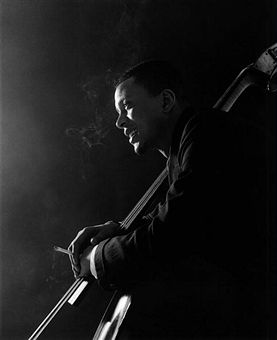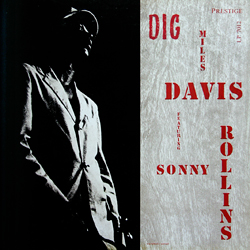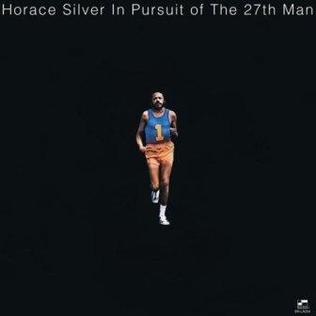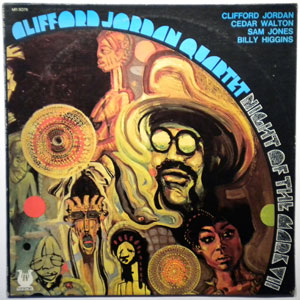
Hard bop is a subgenre of jazz that is an extension of bebop music. Journalists and record companies began using the term in the mid-1950s to describe a new current within jazz that incorporated influences from rhythm and blues, gospel music, and blues, especially in saxophone and piano playing.

Horace Ward Martin Tavares Silver was an American jazz pianist, composer, and arranger, particularly in the hard bop style that he helped pioneer in the 1950s.

Douglas Watkins was an American jazz double bassist. He was best known for being an accompanist to various hard bop artists in the Detroit area, including Donald Byrd and Jackie McLean.

John Gilmore was an American jazz saxophonist, clarinetist, and percussionist. He was known for his tenure with the avant-garde keyboardist/bandleader Sun Ra from the 1950s to the 1990s, and led The Sun Ra Arkestra from Sun Ra's death in 1993 until his own death in 1995.

Dillon "Curley" Russell was an American jazz musician, who played bass on many bebop recordings.

Song for My Father is a 1965 album by the Horace Silver Quintet, released on the Blue Note label in 1965. The album was inspired by a trip that Silver had made to Brazil. The cover artwork features a photograph of Silver's father, John Tavares Silver, to whom the title composition was dedicated. "My mother was of Irish and Negro descent, my father of Portuguese origin," Silver recalls in the liner notes: "He was born on the island of Maio, one of the Cape Verde Islands."

Miles Davis, Volumes 1 & 2 are a pair of separate but related albums by American jazz trumpeter Miles Davis recorded on May 9, 1952, April 20, 1953 and March 6, 1954 and released on Blue Note early 1956. The three sessions were originally released on ten-inch LPs as Young Man with a Horn (1953), Miles Davis, Vol. 2 (1953) and Miles Davis, Vol. 3 (1954), respectively.

A Night at the "Village Vanguard" is a live album by American jazz saxophonist Sonny Rollins recorded at the Village Vanguard in New York City on November 3, 1957 and released on Blue Note the following year.

A Night at Birdland, Vols. 1–3 are three separate but related 10" LPs by the Art Blakey Quintet recorded live at the Birdland jazz club on February 21, 1954, and released on Blue Note later that year, in July, October and November respectively. The quintet features horn section Clifford Brown and Lou Donaldson and rhythm section Horace Silver, Curly Russell and Blakey.

Art Blakey and the Jazz Messengers, also called Moanin', is a studio album by Art Blakey and the Jazz Messengers recorded on October 30, 1958 and released on Blue Note later that year.

Soul Station is an album by American jazz saxophonist Hank Mobley recorded on February 7, 1960 and released on Blue Note later that year. Mobley's quartet features rhythm section Wynton Kelly, Paul Chambers and Art Blakey.

A Night at Birdland, Vols. 1 & 2 are a pair of separate but related live albums by the Art Blakey Quintet. They were recorded at the Birdland jazz club on February 21, 1954 and released on Blue Note in 1956. The performance was originally spread out over three 10" LPs as A Night at Birdland Vols. 1–3 (1954).

Dig is an album by Miles Davis on Prestige Records, catalogue number 7012. It features tracks from a 1951 session at Apex Studios. First released in the 12-inch LP format in 1956, The original album was later released as Diggin' with the catalogue number PR 7281 and a different cover. Dig was reissued as a compact disc with additional tracks.

Horace Silver and the Jazz Messengers is an album by Horace Silver and the Jazz Messengers compiling two 1955 10" LPs—Horace Silver Quintet, Vol. 3 and Horace Silver Quintet, Vol. 4 —recorded on November 13, 1954 and February 6, 1955 respectively and released on Blue Note in October 1956—Silver’s debut 12". The quintet features horn section Hank Mobley and Kenny Dorham and rhythm section Doug Watkins and Art Blakey.

Here's Lee Morgan is an album by jazz trumpeter Lee Morgan originally released on the Vee-Jay label. It was recorded on February 8, 1960, and features performances by Morgan with Clifford Jordan, Wynton Kelly, Paul Chambers and Art Blakey.

In Pursuit of the 27th Man is an album by jazz pianist Horace Silver released on the Blue Note label in 1973, featuring performances by Silver with David Friedman, Randy Brecker, Michael Brecker, Bob Cranshaw, and Mickey Roker.

Minor Move is an album by American hard bop tenor Tina Brooks. It features performances by Brooks, Lee Morgan, Sonny Clark, Doug Watkins and Art Blakey. It was recorded on March 16, 1958, and was the first album Brooks recorded as a leader for the Blue Note label. The album, however, remained unreleased until being issued in Japan in 1980. In 2000, Minor Move was released on CD. The composition "Nutville" is sometimes credited to Lee Morgan, but as producer Michael Cuscuna explains in the liner notes to the 2000 release: "Lee brought the tune to the session, but never claimed credit for it. Curtis Fuller also confirms that it was indeed a Tina Brooks original."

Afro-Cuban is an album by American jazz trumpeter Kenny Dorham, recorded for Blue Note on March 29, 1955 and released later that year on the Blue Note Modern Jazz Series, shortly before the label discontinued the format. It was soon reissued on the new 1500 series, recompiled with a session by an early incarnation of the ensemble, with new cover art.

1958 – Paris Olympia is a live album by drummer Art Blakey's Jazz Messengers recorded at L'Olympia in 1958 and originally released on the French Fontana label.

Night of the Mark VII is a live album by saxophonist Clifford Jordan which was recorded in 1975 and first released on the Muse label.




















